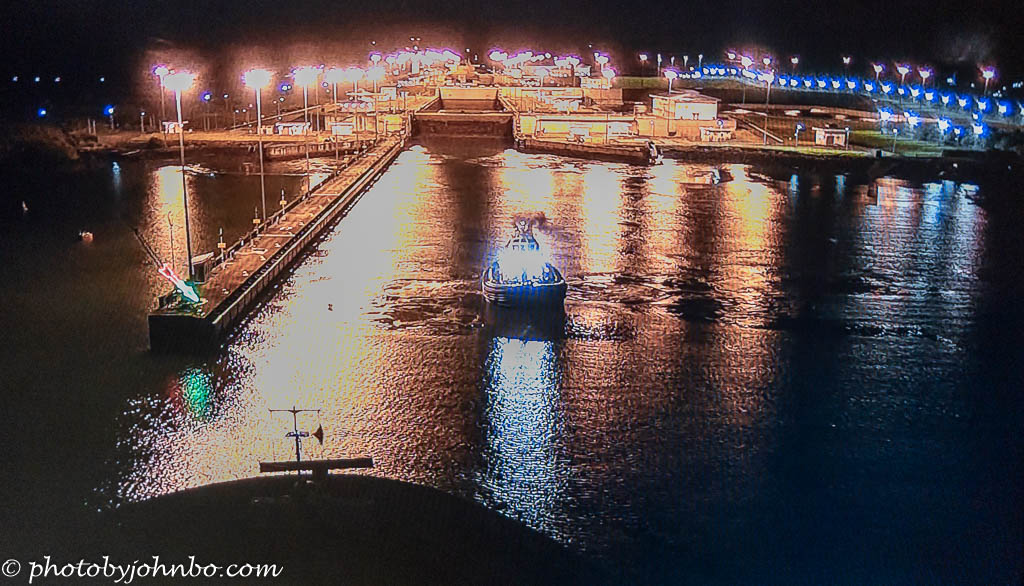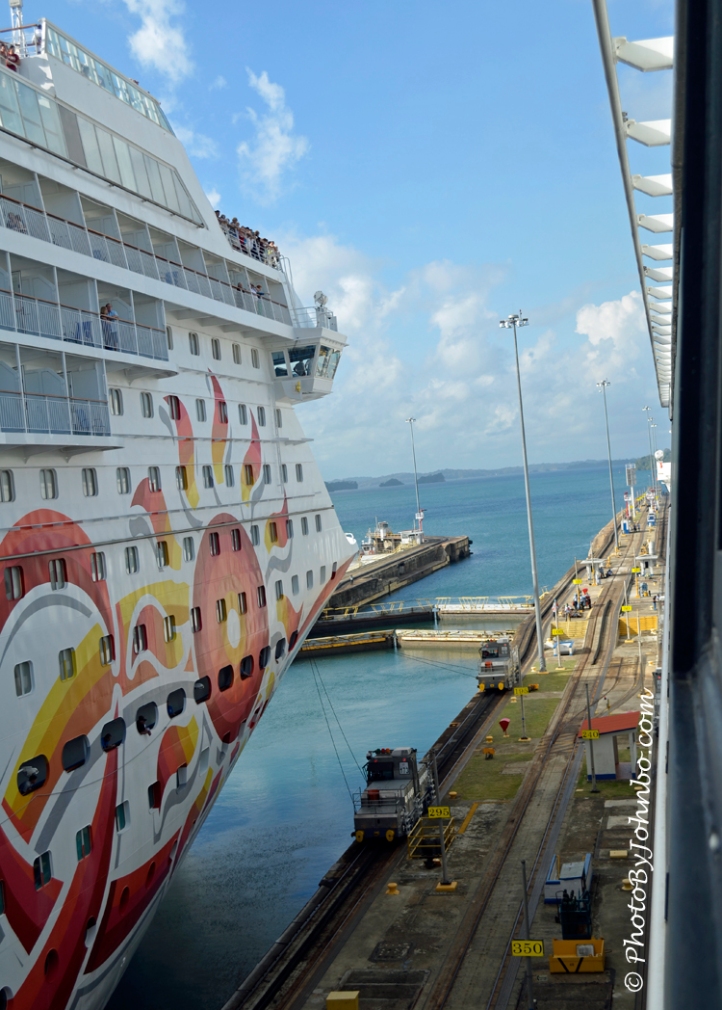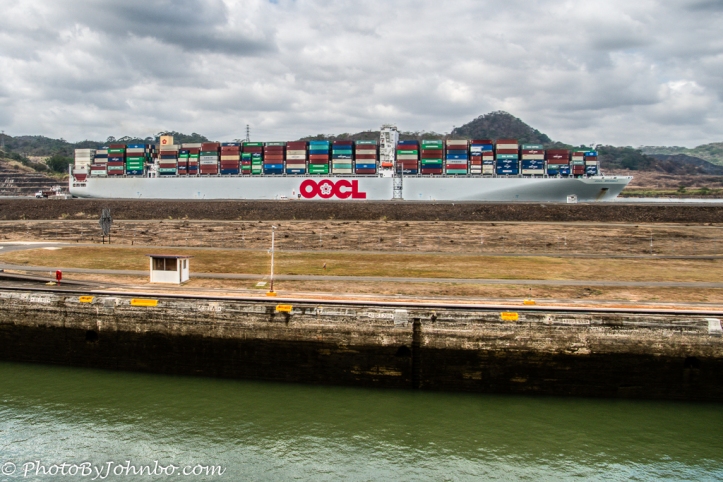
Panama City, Panama.
One of my travel goals after retiring was to cross between two continents at the Panama Canal. In 2013, we made what we thought would be a once-in-a-lifetime trip for us. What was new for us on this, our third trip through the canal, is that part of the journey was at night, and we were on the Norwegian Bliss, a much larger ship that is required to use the new and larger locks that opened in 2015. My opening image is a snapshot of the bow camera as seen on our cabin’s television. We were escorted by a tug into the lock area but before we entered the lock, the tug moved out of the way.

I’m embarrassed at the quality of the images I shared in that 2013 post as I’d just started the blog and my education in digital photo editing and composition. At the time, we were on one of the largest ships that could fit through the canal, the Norwegian Pearl. We sailed from Miami to Los Angeles.

Then in 2018, my sister and her friend asked me about our Panama Canal journey. After telling them about the journey and the places we saw in addition to the trip through the canal, they asked us if we’d like to join them on their journey through the canal. In 2019, it became a family affair with several family members joining us on the Norwegian Star, a similar-sized ship to the Pearl. We sailed from Los Angeles to Miami and on that journey, we were still in the original locks that opened in 1914, but the canal opened new and larger locks in 2015 to accommodate larger ships. Click on the image above to revisit that post.
The entrance to the canal on the Pacific Ocean side is just past the Bridge of the Americas. Since the canal was built, until this bridge was built, there was only a ferry available to carry vehicles across the new chasm. This view of the bridge was captured on the afternoon before our late-night journey through the canal began.
We left the dock at Panama City around 9 PM but the ship waited in the Pacific Ocean until its scheduled canal transit would begin at around 1:45 AM. We went to bed early and set the alarm to wake us up in time for us to see the first set of locks.
Most of the images in this post were captured from the balcony of our cabin on deck 15. As you can see in the photo, our ship is much taller than the lights illuminating the lock area. Unlike the original locks, ships are not escorted by ropes using the mechanical “mules” and a Panama Canal pilot is responsible for helping the ship’s captain to enter the lock without damaging the ship or the lock.
The Colon locks raise the ship from sea level to about 85 feet (25 m) above sea level, the water level at Lake Gatun. Once we transited the three locks we entered the Culebra Cut, the largest section of man-made canal that is the entrance to Lake Gatun. We slept through this section of the canal so we would be awake and ready for more views early the next morning.
Several streams flow into the canal. Some are manmade, and some like this one, appear to be natural. The scenery along the canal is beautiful so it’s a shame that part of it was not visible on the nighttime portion of our journey.
Workers on a nearby barge were interested in the Norwegian Bliss. I zoomed in on the original high-resolution image to see that both of them had their cell phones in either photo or video mode capturing the ship as we sailed by.
As we entered Lake Gatun, we could see that the manmade lake created many islands in the channel that is part of the Chagres River on the Atlantic side.
Near the Atlantic Ocean entrance to the canal, there is a dam that created Lake Gatun. The large lake acts as storage for the water needed to operate the locks. One feature of the new locks is that storage lagoons store water to reuse within the locks to lower the fresh water loss with each change in lock levels. The older locks drain fresh water from Lake Gatun into the oceans with every lock operation.
This part of the canal was widened during the construction of the new locks to allow two-way traffic. Before the construction of the new locks, this part of the canal was much more narrow. In the distance, you can see the Centennial Bridge, one of only three bridges that cross the canal.
Going past the dam on the Chagres River that created Lake Gatun, we approached the Agua Clara locks, the set of three locks that will lower the Bliss to sea level. Locks, like airports, have control towers that keep an eye on all operations of the locks.
The giant lock gates are responsible for holding back many tons of water. Each lock is some 1400 feet (427 m) in length. The Agua Clara locks are in an entirely separate channel from the original locks.
After passing through the last lock, it’s a short sail to the Atlantic Ocean. You can see it in the view above if you look beyond the Atlantic Bridge in the background.
After passing through the Agua Clara locks, it’s only a short distance to the Bridge of the Atlantic and our entrance to the Atlantic Ocean. I have many more photos captured during the canal transit. You can find 2K HD versions of my entire library of Panama Canal transit images captured during this latest crossing on my Flickr site here.
John Steiner














A wonderful thing to do John. Great photos and walk through 🙂
Thanks, Brian. It is an educational and fascinating journey through an architectural wonder.
What a journey! Such a shame some of it had to be by night. Great photos.
We were a bit disappointed at the night passage through one of the main cuts, but the schedule is Panama’s to provide. Even the cruise ships don’t have a say about when they are assigned, given their arrival constraints and other traffic scheduled.
It’s an amazing feat of engineering, isn’t it, John?
It truly is! It was especially interesting to see the new, much more modern locks designed in the 21st century.
One our favorites trips was the Road Scholar program on the Panama Canal. We did a day time transit if the Canal in a small vessel that could hold up to 100 passengers. It was wonderful, exciting, and educational. Gave me an appreciation for the supply chain.
A small vessel trip through the canal would be cool. Maybe I should consider another passage…. hmmmm 🙂
An amazing adventure – I’d love to do this one day! The skill involved in getting such a large ship into such a (relatively) narrow lock is impressive/
I certainly wouldn’t want the responsibility of navigating a ship that cost north of a billion dollars US through those tight locks. The Captain and the Pilot of the Locks who boarded at Panama made it look easy.
This is a great post John. Beautiful images and wonderful education. I’ve always wanted to go through the Canal. Maybe someday. Do I sound jealous??
After three trips through, I find something new to see every time. It’s one of the best journeys of my lifetime.
😊
Cool pix of new larger locks; we obviously had only seen the old smaller version….gotta admit tho that the mules were pretty cool. Still don’t understand how a ship that big floats!!! Kinda like airplanes flying. Where are you guys wintering this year?
Jan Hernandez
>
I was surprised when we didn’t see the mules in the new locks. I wonder if they could get along without them in the old locks given today’s ship propulsion technology.
We are in North Carolina through the end of January. In early February we have another cruise scheduled, then we’ll finish the winter in Arizona. Well, that’s not quite true, North Dakota isn’t quite done with winter by mid-April when we return home. >grin<
I’ve never seen the locks, thank you for the photos, John. 👍🏻
They are a cool and truly energy saving technology given the fuel and time savings by avoiding travel to the bottom of South America.
Yes, I’ve seen that on a map, the canal takes a serious amount of distance out.
John, thanks so much for this post! I really enjoyed the photos and descriptions of the locks. In November we made a partial transit through the Gatun Locks from Colon into Gatun Lake and back to the Atlantic in one day. It was fascinating to see how it all worked. We watched several larger vessels going through the new part of the canal as we went through the old.
It is always interesting to me to see the technology that saves so much energy.
This is beautiful John 🤩
Thanks!
How fascinating this was, John! I’m glad you shared the photos and stories.
What an amazing experience, John. Thanks for letting me come along.
Thanks, Janet!
Great tracking your journey John!
[…] In my Travel Tuesday post this week, I shared images from our most recent trip through the Panama Canal. Our main reason for the latest trip was to see the 21st-century locks capable of handling much larger ships. If you missed it, that post is here. […]